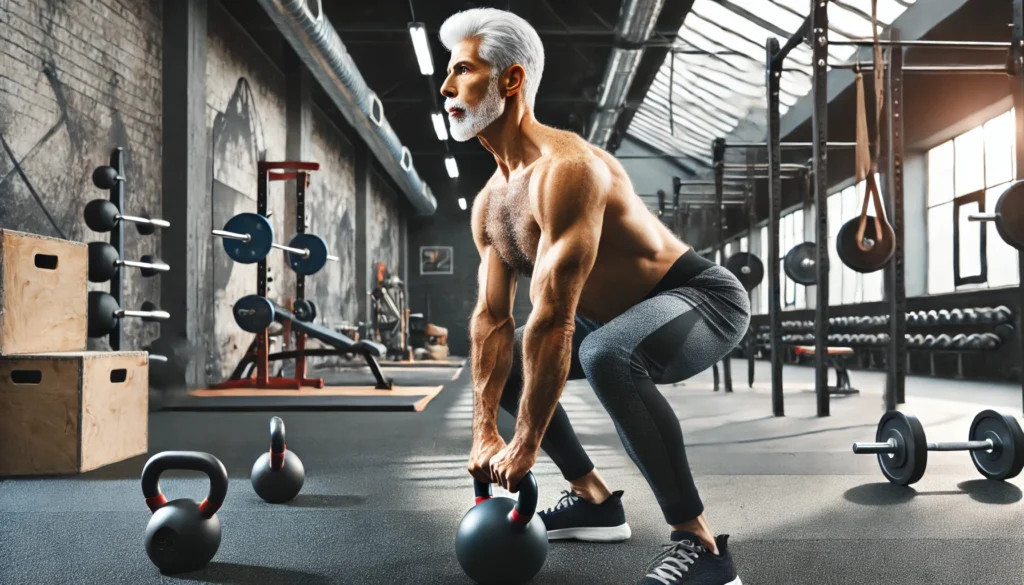Introduction: The Importance of Strength Training for Men Over 60
As men age, maintaining muscle mass, strength, and overall fitness becomes increasingly crucial. Strength training is not just about aesthetics or lifting heavy weights; it plays a vital role in overall health, mobility, and quality of life. Engaging in regular strength workouts helps combat age-related muscle loss, enhances bone density, and supports cardiovascular health. For men over 60, adopting a well-structured strength training regimen can help sustain independence, prevent injuries, and improve metabolic health. This article explores the best strength training workouts for men over 60, offering practical guidance on how to build muscle and stay active well into the later years.
You may also like: Best Workout for Guys Over 40: Proven Routines to Build Strength and Stay Fit
Understanding the Benefits of Strength Training for Men Over 60
Strength training, often associated with bodybuilding and powerlifting, is equally essential for older adults. One of the most significant benefits is its ability to counteract sarcopenia—the natural decline in muscle mass that occurs with aging. Without resistance training, men over 60 may lose as much as 3-5% of their muscle mass per decade. This loss contributes to reduced strength, balance issues, and a heightened risk of falls and fractures.
Beyond muscle retention, strength training improves joint health, enhances posture, and alleviates chronic pain, particularly in areas like the lower back and knees. Regular resistance workouts also have a profound impact on metabolic health, aiding in weight management and reducing the risk of type 2 diabetes. Additionally, research suggests that strength training benefits cognitive function, helping to delay cognitive decline and improve overall brain health.
Key Considerations Before Starting Strength Training After 60
Before embarking on a strength training regimen, men over 60 should consider several factors to ensure a safe and effective workout experience. Consulting with a physician is a crucial first step, especially for individuals with pre-existing conditions such as hypertension, arthritis, or cardiovascular disease. A thorough medical evaluation can identify any limitations and provide guidance on safe exercise modifications.
Warm-ups and cool-downs become increasingly important with age. Dynamic stretching, light cardio, and mobility exercises prepare the body for more intense movements and reduce the risk of injury. Proper technique is another critical consideration, as lifting weights with incorrect form can lead to strains, sprains, or long-term joint damage. Men over 60 should prioritize controlled movements and avoid excessive momentum to prevent unnecessary stress on the body.
Lastly, consistency and progression are key. While younger individuals may see rapid gains, older adults should adopt a gradual approach to increasing resistance. A well-balanced routine focusing on major muscle groups will yield long-term benefits, allowing for steady improvements in strength and endurance without excessive strain.

Best Strength Training Workouts for Men Over 60
Full-Body Strength Routine
A full-body strength workout is ideal for men over 60 as it engages multiple muscle groups in a single session. This approach maximizes efficiency, allowing individuals to build strength without spending excessive time in the gym. A well-rounded routine should include the following exercises:
- Squats – Squats are fundamental for lower body strength, targeting the quadriceps, hamstrings, and glutes. They also enhance core stability and improve balance. For those with knee issues, chair squats or wall-supported squats can be excellent alternatives.
- Push-ups (or Modified Push-ups) – This exercise strengthens the chest, shoulders, and triceps while engaging the core. Modified push-ups, such as incline push-ups against a wall or bench, offer a joint-friendly variation for beginners.
- Dumbbell Rows – Strengthening the back muscles is essential for maintaining posture and preventing injuries. Using light dumbbells, individuals can perform rows to engage the lats, traps, and biceps.
- Seated Shoulder Press – Pressing overhead with dumbbells helps build deltoid strength, which is crucial for maintaining upper body function. Seated variations provide stability and reduce spinal strain.
- Leg Curls (Using Resistance Bands or Machines) – Strengthening the hamstrings improves mobility and reduces the risk of falls. Resistance bands provide a joint-friendly alternative to machine-based curls.
- Calf Raises – Simple but effective, calf raises enhance lower leg strength and improve ankle stability, which is critical for balance and mobility.
- Planks – Core strength is essential for spinal health and overall stability. Holding a plank position for 20-30 seconds engages the abs, obliques, and lower back muscles.
Strength Training Split Routine
For those who prefer a more structured approach, a split routine targeting specific muscle groups on different days can be highly effective. A three-day split may include:
- Day 1: Upper Body Strength Training
- Day 2: Lower Body Strength Training
- Day 3: Core and Functional Movements
Each session should incorporate compound movements, isolation exercises, and flexibility work to ensure balanced development and injury prevention.
Progressive Overload and Recovery Strategies
Building muscle and maintaining strength requires progressive overload—the gradual increase of resistance or intensity. However, recovery is equally important, as muscles need adequate rest to repair and grow. Men over 60 should prioritize sleep, proper nutrition, and hydration to support muscle recovery. Rest days between workouts allow the body to adapt and prevent overtraining, which can lead to injuries.
The Role of Nutrition in Strength Training Over 60
Nutrition plays a vital role in muscle growth and overall fitness. Protein intake is crucial for muscle repair, with sources like lean meats, fish, eggs, dairy, and plant-based proteins offering essential amino acids. Adequate carbohydrate intake fuels workouts, while healthy fats support hormone production and joint health. Hydration is also essential, as dehydration can impair performance and recovery.

Frequently Asked Questions (FAQ) on Fitness Over Sixty
1. What are the key benefits of an over 60 workout routine?
Engaging in an over 60 workout routine offers numerous benefits, including improved cardiovascular health, enhanced muscle strength, and better joint flexibility. Regular physical activity helps to maintain bone density, reducing the risk of osteoporosis, a common concern for older adults. Additionally, workouts for men over 60 and exercises for women over 60 can enhance balance and coordination, decreasing the likelihood of falls and injuries. Another crucial advantage is the positive impact on mental well-being—consistent fitness for men over 60 and fitness for women over 60 has been linked to reduced stress, improved cognitive function, and lower risks of depression. Overall, incorporating an exercise routine for men over 60 and workouts for women over 60 can significantly enhance quality of life and longevity.
2. How can I safely start an exercise routine for men over 60 or workouts for women over 60?
The key to safely starting an over sixty workout regimen is to begin gradually and choose exercises tailored to your fitness level. It’s essential to consult with a healthcare provider before beginning any new fitness for women over 60 or fitness for men over 60 plan. Start with low-impact activities like walking, swimming, or cycling to build endurance and flexibility. Strength training should be introduced gradually with light weights or resistance bands to prevent injury. Additionally, incorporating balance and stretching exercises can enhance mobility and reduce the risk of falls while easing the body into more intense physical activity.
3. What types of exercises are best for fitness for men over 60 and fitness for women over 60?
A well-rounded fitness routine should include cardiovascular exercises, strength training, flexibility work, and balance-enhancing activities. Cardiovascular workouts such as brisk walking, swimming, or low-impact aerobics are excellent for maintaining heart health. Strength training is crucial for preventing muscle loss, so exercises like bodyweight squats, resistance band workouts, or light dumbbell routines are beneficial. Yoga or Pilates can improve flexibility, which is essential for joint health and mobility. Lastly, balance exercises like tai chi or standing heel raises are particularly helpful in reducing fall risks, a common concern in fitness over sixty programs.
4. How often should I engage in workouts for men over 60 and exercises for women over 60?
The recommended frequency for an over 60 workout plan depends on individual fitness levels and goals. Generally, engaging in moderate aerobic activity for at least 150 minutes per week, combined with strength training exercises twice a week, is ideal. If starting with lower endurance, shorter sessions spread throughout the week can still provide significant benefits. Balance and flexibility exercises should be incorporated daily, especially for those focusing on fitness over sixty. Always listen to your body and allow adequate rest between sessions to prevent overuse injuries.
5. Are there specific exercises to avoid in an over sixty workout?
Certain high-impact and high-risk exercises should be approached with caution or avoided entirely. Exercises that involve sudden, jarring movements—such as high-intensity interval training (HIIT), heavy deadlifts, or deep squats—may put excessive strain on aging joints and muscles. High-impact activities like running on hard surfaces or jumping exercises can increase the risk of injury. Instead, modifications such as using resistance bands, bodyweight exercises, or machines with controlled movements can make workouts for men over 60 and workouts for women over 60 safer and more effective.
6. How does strength training benefit fitness for men over 60 and fitness for women over 60?
Strength training is essential in an over sixty workout plan as it combats muscle loss and supports metabolic health. Regular resistance exercises improve muscle tone, which can enhance posture and reduce the risk of falls. Strength training also plays a critical role in maintaining bone density, helping to prevent osteoporosis. Moreover, it supports joint stability and can reduce arthritis-related discomfort. Even bodyweight exercises or light resistance band movements can yield substantial benefits, making them essential in any fitness over sixty program.
7. Can workouts for women over 60 and workouts for men over 60 help with chronic conditions?
Absolutely. Engaging in fitness for women over 60 and fitness for men over 60 can effectively manage and sometimes even alleviate symptoms of chronic conditions. Regular physical activity can help control blood sugar levels for individuals with diabetes, improve cardiovascular health, and reduce hypertension. Additionally, gentle movement exercises like yoga or swimming can ease joint pain associated with arthritis. For those with osteoporosis, weight-bearing exercises such as walking and resistance training help to strengthen bones. Tailoring an over 60 workout plan to accommodate medical conditions ensures both safety and effectiveness.
8. How important is flexibility training in an exercise routine for men over 60 and exercises for women over 60?
Flexibility training is crucial for maintaining mobility and reducing stiffness that often comes with aging. Stretching exercises, yoga, and Pilates help improve range of motion, decrease muscle tightness, and enhance overall functional movement. Incorporating stretching into workouts for men over 60 and workouts for women over 60 can also prevent injuries and improve posture. Flexibility work should be done regularly, preferably after a warm-up or workout session, to optimize results. A well-balanced fitness over sixty plan includes flexibility as a key component for long-term physical health.
9. How can fitness over sixty contribute to mental health and emotional well-being?
Regular physical activity plays a significant role in mental and emotional well-being, particularly for those engaging in an over sixty workout routine. Exercise releases endorphins, which help reduce stress and enhance mood. Physical activity also supports cognitive function, lowering the risk of memory-related conditions such as dementia. Engaging in group fitness for women over 60 or fitness for men over 60 can foster social interactions and reduce feelings of isolation. Overall, staying active contributes to greater confidence, improved sleep patterns, and a more positive outlook on life.
10. What are some practical tips for staying motivated with an exercise routine for men over 60 and workouts for women over 60?
Staying motivated with an over sixty workout regimen requires setting realistic goals and maintaining a sense of enjoyment. Finding activities that bring pleasure, such as dancing, hiking, or group classes, can keep exercise engaging. Keeping a fitness journal to track progress can provide motivation and accountability. Partnering with a workout buddy or joining a community fitness class can help sustain commitment. Lastly, varying workouts for men over 60 and exercises for women over 60 by trying new activities prevents boredom and keeps fitness routines exciting and effective.

Conclusion: Staying Strong and Active Beyond 60
Strength training is a powerful tool for maintaining health, vitality, and independence as men age. Incorporating a well-structured workout routine, focusing on proper technique, and prioritizing recovery will ensure long-term success. By committing to regular strength training, men over 60 can enhance their quality of life, prevent age-related decline, and continue to lead active, fulfilling lives.
senior fitness programs, low-impact workouts, strength training for seniors, best exercises for aging adults, senior citizen workout plans, flexibility exercises for older adults, joint-friendly workouts, mobility exercises for seniors, cardio for older adults, healthy aging and exercise, weight training for seniors, senior wellness routines, home workouts for older adults, balance exercises for seniors, improving bone density with exercise, arthritis-friendly workouts, functional fitness for seniors, exercise safety for older adults, maintaining muscle mass after 60, active aging strategies
Further Reading:
Workout Routines for Men: The Ultimate Guide
Over 60? Here Are the 5 Best Muscle-Building Workouts You Can Do
Strength Training for Seniors: A 20-Minute Workout
Disclaimer
The information contained in this article is provided for general informational purposes only and is not intended to serve as medical, legal, or professional advice. While Health11News strives to present accurate, up-to-date, and reliable content, no warranty or guarantee, expressed or implied, is made regarding the completeness, accuracy, or adequacy of the information provided. Readers are strongly advised to seek the guidance of a qualified healthcare provider or other relevant professionals before acting on any information contained in this article. Health11News, its authors, editors, and contributors expressly disclaim any liability for any damages, losses, or consequences arising directly or indirectly from the use, interpretation, or reliance on any information presented herein. The views and opinions expressed in this article are those of the author(s) and do not necessarily reflect the official policies or positions of Health11News.


